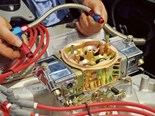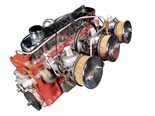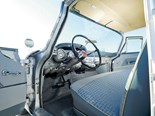How it works: heads, valves, ports and combustion chambers
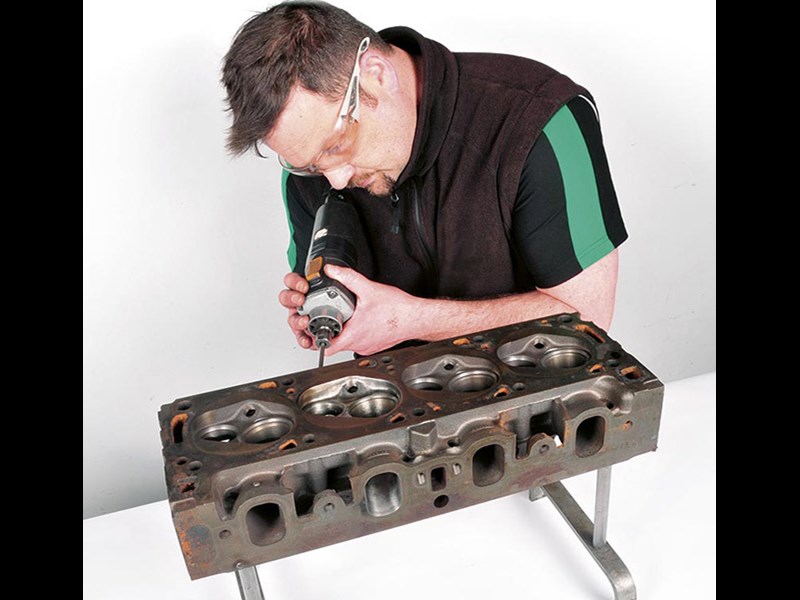 A Cleveland being ported
A Cleveland being ported

 The flat areas that overlap the bores aid turbulence, reduce detonation and increase compression
The flat areas that overlap the bores aid turbulence, reduce detonation and increase compression
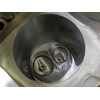
 A sectioned factory 308 inlet port
A sectioned factory 308 inlet port
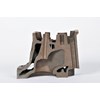
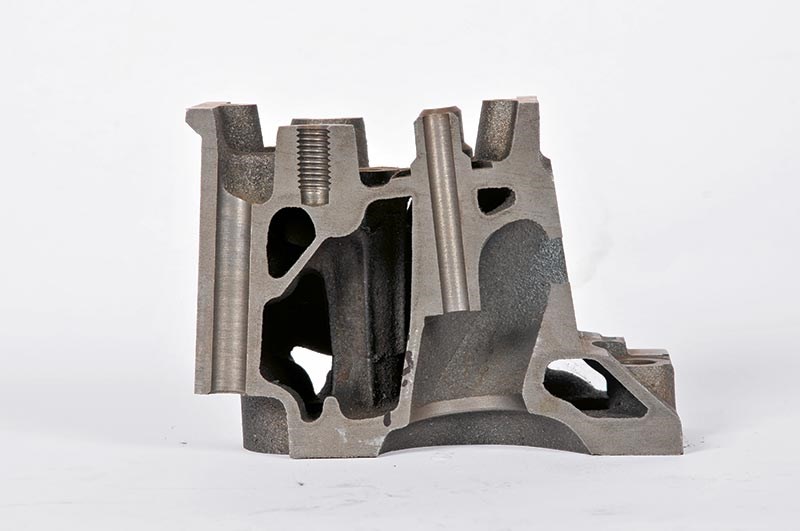 A 308 exhaust port. Note the generous coolant passages around the exhaust port and bowl
A 308 exhaust port. Note the generous coolant passages around the exhaust port and bowl

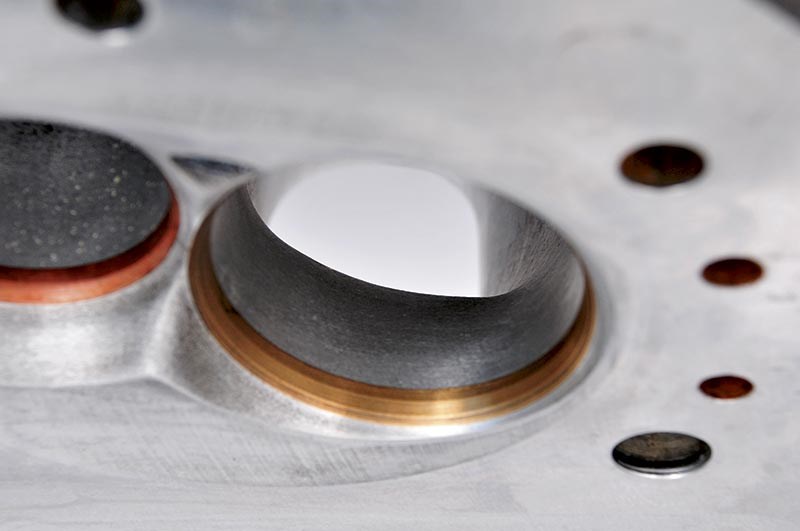 A 308 exhaust port. Note the generous coolant passages around the exhaust port and bowl
A 308 exhaust port. Note the generous coolant passages around the exhaust port and bowl

.jpg) A reworked exhaust port. Note the direct flow path from the exhaust valve
A reworked exhaust port. Note the direct flow path from the exhaust valve
.jpg)
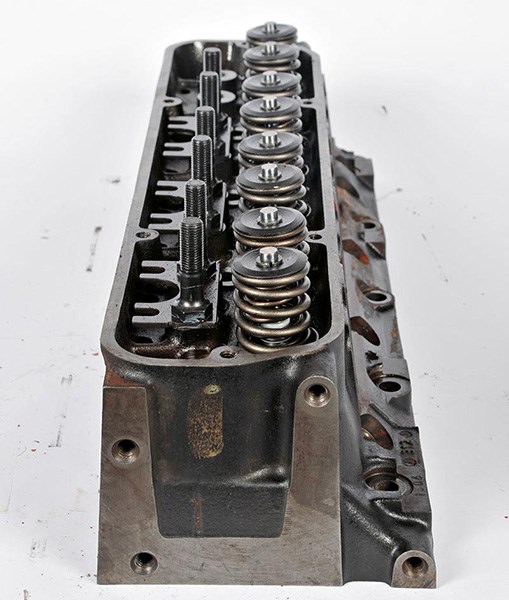 The much more upright valves in a Holden
The much more upright valves in a Holden

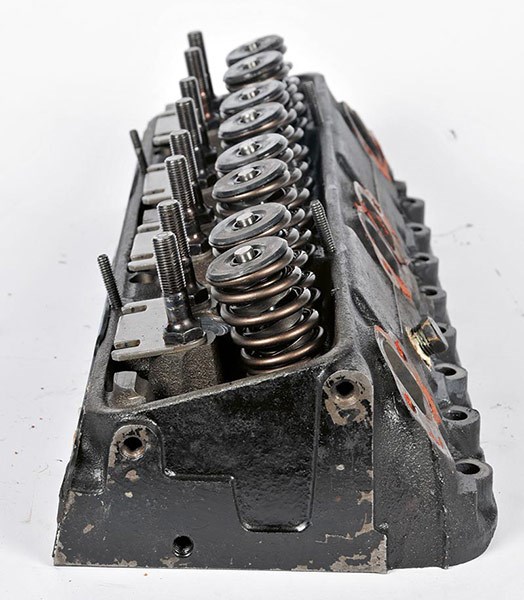 The classic 23-degree Chev head
The classic 23-degree Chev head

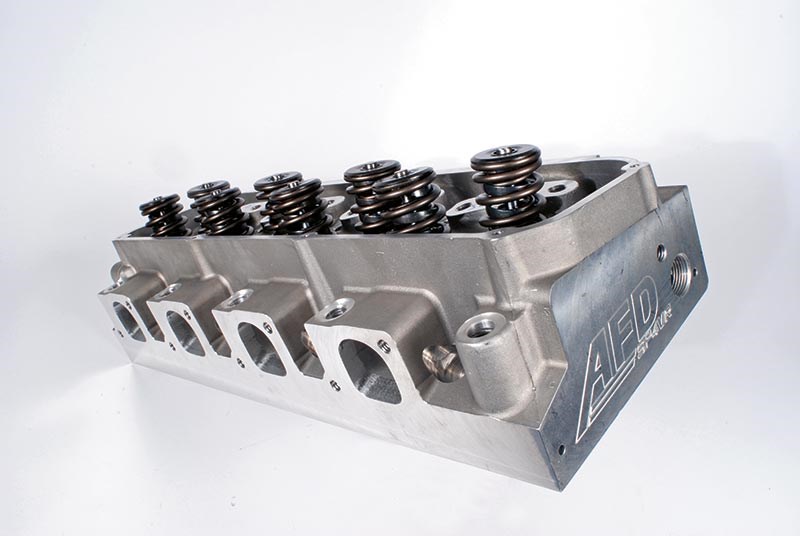 A locally-made Cleveland replacement head. Unlike Chevs and Holdens, Clevelands have 'canted' valves
A locally-made Cleveland replacement head. Unlike Chevs and Holdens, Clevelands have 'canted' valves

 Original Holden rocker gear is fine for standard use or very mild performance
Original Holden rocker gear is fine for standard use or very mild performance

 Big-block Chevs also have canted valves. These direct flow more effectively
Big-block Chevs also have canted valves. These direct flow more effectively

 The valve seat angles most often used are 30, 45 and 70 degrees, measured in relation to the chamber face of the head
The valve seat angles most often used are 30, 45 and 70 degrees, measured in relation to the chamber face of the head

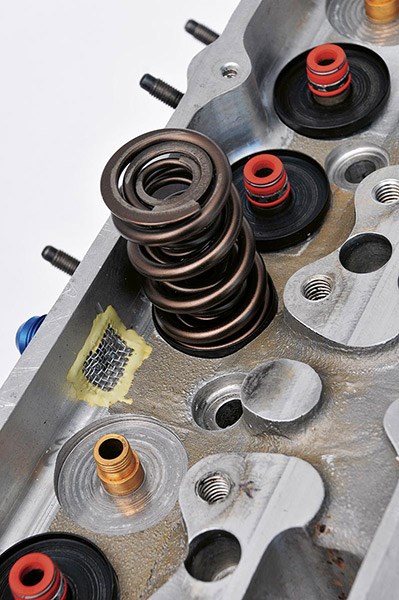 Rotators allow springs to rotate freely. Uprated valve stem seals are a good idea
Rotators allow springs to rotate freely. Uprated valve stem seals are a good idea

 A Chev wedge chamber resulting from the 23-degree valve angle
A Chev wedge chamber resulting from the 23-degree valve angle

 A chamber being accurately measured or cc'd
A chamber being accurately measured or cc'd

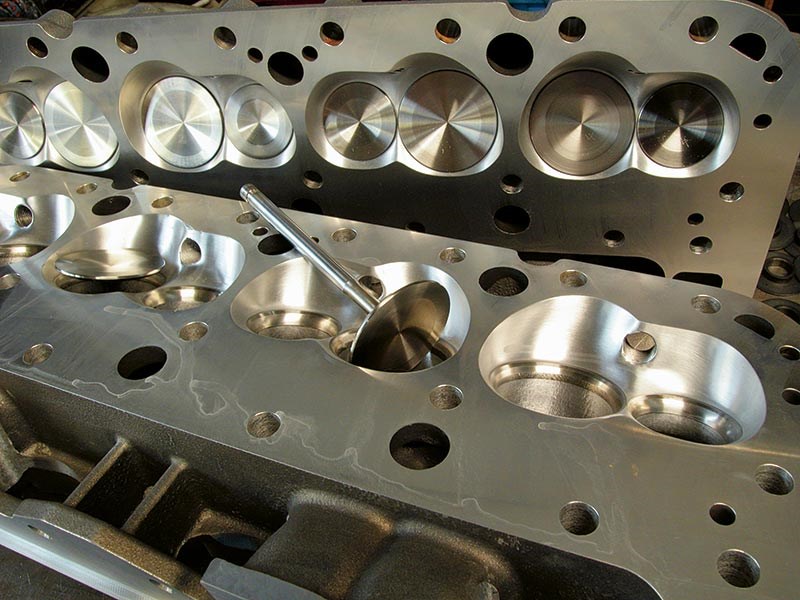 Note the valve has been 'necked' to reduce restriction through the port. Heads are milled on the gasket face to adjust compression
Note the valve has been 'necked' to reduce restriction through the port. Heads are milled on the gasket face to adjust compression

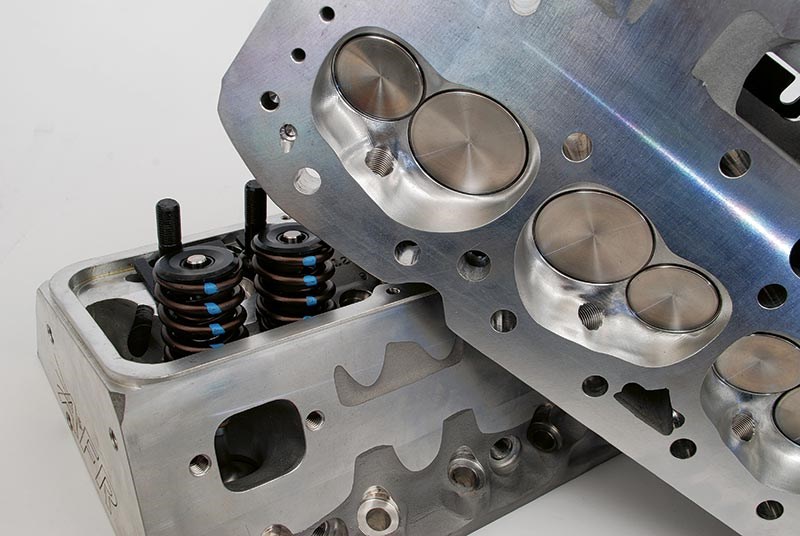 Ideally, the spark plug is as close as possible to the centre of the chamber, oriented toward the exhaust valves
Ideally, the spark plug is as close as possible to the centre of the chamber, oriented toward the exhaust valves

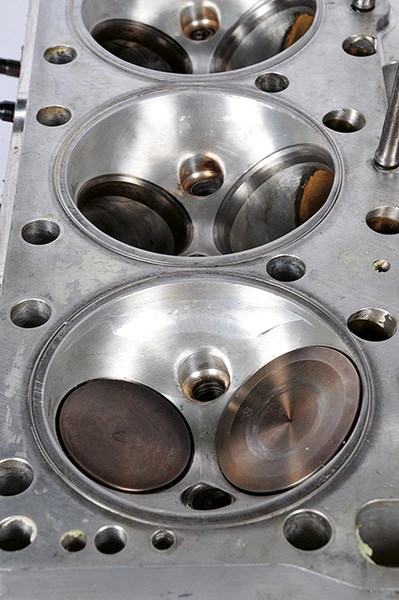 A Keith Black head with hemispherical chambers as used in a Top Fuel dragster
A Keith Black head with hemispherical chambers as used in a Top Fuel dragster

 Canted valves, as in this Cleveland head, use individual rockers
Canted valves, as in this Cleveland head, use individual rockers
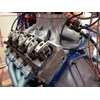
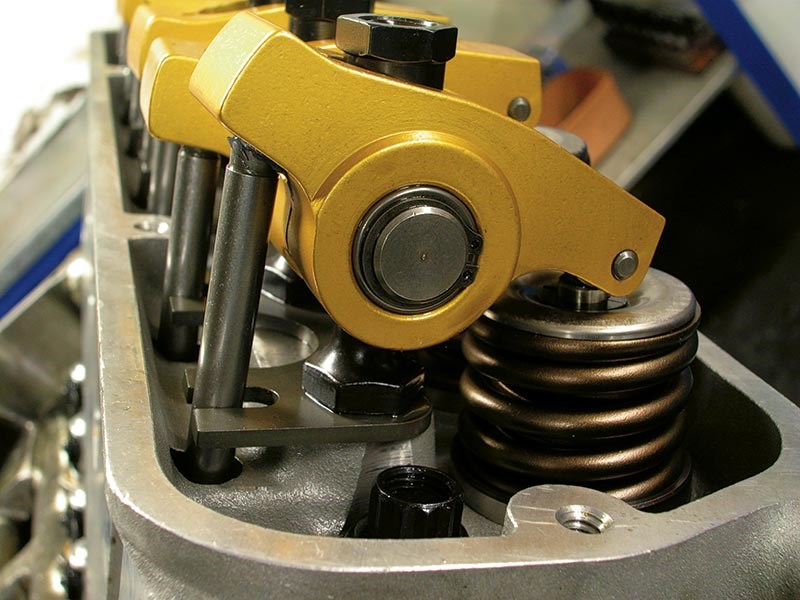 Much stronger shaft-mounted Crane rockers suit high performance springs
Much stronger shaft-mounted Crane rockers suit high performance springs


|
|
A Cleveland being ported
|

|
|
The flat areas that overlap the bores aid turbulence, reduce detonation and increase compression
|

|
|
A sectioned factory 308 inlet port
|

|
|
A 308 exhaust port. Note the generous coolant passages around the exhaust port and bowl
|

|
|
A 308 exhaust port. Note the generous coolant passages around the exhaust port and bowl
|
.jpg)
|
|
A reworked exhaust port. Note the direct flow path from the exhaust valve
|

|
|
The much more upright valves in a Holden
|

|
|
The classic 23-degree Chev head
|

|
|
A locally-made Cleveland replacement head. Unlike Chevs and Holdens, Clevelands have 'canted' valves
|

|
|
Original Holden rocker gear is fine for standard use or very mild performance
|

|
|
Big-block Chevs also have canted valves. These direct flow more effectively
|

|
|
The valve seat angles most often used are 30, 45 and 70 degrees, measured in relation to the chamber face of the head
|

|
|
Rotators allow springs to rotate freely. Uprated valve stem seals are a good idea
|

|
|
A Chev wedge chamber resulting from the 23-degree valve angle
|

|
|
A chamber being accurately measured or cc'd
|

|
|
Note the valve has been 'necked' to reduce restriction through the port. Heads are milled on the gasket face to adjust compression
|

|
|
Ideally, the spark plug is as close as possible to the centre of the chamber, oriented toward the exhaust valves
|

|
|
A Keith Black head with hemispherical chambers as used in a Top Fuel dragster
|

|
|
Canted valves, as in this Cleveland head, use individual rockers
|

|
|
Much stronger shaft-mounted Crane rockers suit high performance springs
|
We lift the lid on heads, valves, ports and combustion chambers...

|
|
How it works: cylinder heads, valves, ports and combustion chambers
|
HEADS, VALVES, PORTS AND COMBUSTION CHAMBERS - HOW THEY WORK
Put simply, cylinder heads are complex lids for cylinders. They seal one end of the bores in which the pistons slide, they admit fresh petrol-air mixture, provide a space for it to burn, locate the spark plug which starts that process, and they allow waste gases to be expelled. In many cases, the heads also carry either one or two camshafts which open and close the doors through which fuel and exhaust gasses travel, or a system of rockers that does much the same.
While heads are important, they don’t function alone. Properly designed inlet or exhaust manifolds - literally the pipes that direct gas in and out – can have a huge effect on efficiency. Similarly, the wrong cam or a poorly set up valvetrain will also rob performance. In reality, everything in an engine has to be compatible with everything else, although there’s always some compromise involved. Discussing every aspect of even basic engine design in detail could – and does – fill many books, so we’ll restrict ourselves to the basic functions of the cylinder head.
KNOW YOUR REQUIREMENTS
If you just want to putt sedately down the road in your restored classic, standard heads will be quite adequate. Need more sprightly performance on the road? Again, the standard heads will do the trick, but might need a little attention to detail.
Taking things further will call for either extensive work to the original heads – and indeed the whole engine - or aftermarket performance units. Any need for still more power will definitely require either specialist knowledge or deep pockets to pay for expert skills.
BASIC TIPS
Decide in advance what you want your engine to do – and stick to it. Do your homework before ringing an engine builder: the more you read, the more questions you’ll be able to ask.
While it might sound like a good idea to throw lots of money at your engine to get more performance, beware the tuner, builder or mechanic who promises outrageous power increases: such benefits often come at the cost of reliability, driveability, fuel consumption and some other factors – and where’s the fun in having a car that overheats in traffic, uses as much fuel as a long-haul Boeing and has the life-span of a grenade with a missing pin?
KEY ISSUES
There are various factors affecting efficiency and performance of a cylinder head on any engine, no matter how old, how big or how many cylinders it has. The size, shape and location of the inlet and exhaust ports dictate how much air reaches the inlet valve(s) and how effectively exhaust gases are removed. The size and orientation of the valves influence gas flow into and out of the combustion chamber. The size, shape and orientation of the combustion chamber itself is also a major influence on cylinder filling, turbulence, burn characteristics, inlet and outlet flow.
PORTS
Because gas usually flows into and out of heads from the sides, it often turns through about ninety degrees along the way and this can have a negative impact on flow. Inside an inlet, such a turn is particularly tight around what’s unimaginatively known as the short-turn radius.
The fuel-laden air here doesn’t need to flow nearly as fast as it does on the other side of the port, maybe just a couple of centimetres away; as a result it can ‘stall’ or eddy, disrupting efficient gas-flow in a process which takes place thousands of times a minute; (What did you think RPM meant?) Altering the shape of the short-turn radius to prevent ‘separation’ during high volume flow is part of a process called ‘porting’. However, care is needed because getting the shape wrong can easily hurt flow and make an engine less efficient, not more so.
Performance porting sometimes involves making the port bigger to allow greater flow, or polishing the port so there’s less friction against the port’s wall. In exhaust ports, polishing also slows down the build-up of carbon – which can narrow the port to a small but appreciable degree and also slow or disrupt gas velocity by offering a rough surface. Again, done incorrectly, this can hurt flow.
Gas flow into and out of engines is a major design consideration, as it influences not only how much power is developed, but how it’s developed. No-one wants a street engine that delivers power only at very high revs, or with big gaps in the delivery: modern engine designers do actually know what they’re doing! Even the old guys had developed some pretty clever ideas, long before computers, 3D modelling, Computational Fluid Dynamics and even dynamometers. Another approach for really powerful engines is to alter the inlet port itself so that air flow follows a longer, straighter path. Of course, this is a fundamental design change made during manufacture rather than a modification to an existing head. It results in what’s known as a high-port head. Motorcycle engines often have virtually straight inlet ports.
VALVES
Valves – sometimes called "a penny on a stick" - are deceptively complex. Heads and stems of standard valves are made separately and welded together. The resulting two-piece valves are fine for regular or mild performance applications. However, beware the results of the penny dropping off its stick… Higher quality valves are made from one-piece stainless steel forgings. In racing engines, titanium or even more exotic materials are used.
Valve sizes have to be matched to port volumes: bigger valves let in exponentially more air. As lift – the distance a valve opens - increases, larger valves will also allow more flow.
The angles at which valves sit in heads also affect performance. In original cast iron small-block Chev heads, the valves are at 23-degrees to the gasket face, giving the combustion chambers in early a distinct wedge shape. Although the 23-degree head can be modified, it’s far from ideal. It was straightened up to 18 degrees to improve performance and aftermarket manufacturers continued the trend, reducing the angle to around 15 degrees. In the LS7 engine the stems are at 12 degrees.
COMBUSTION CHAMBERS
Combustion chambers come in various shapes. The main ones are ‘bathtub’, ‘wedge’, ‘hemispherical’ (as in the Chrysler Hemi), ‘pentroof’, common in modern 4-valve engines and Herron, which are completely flat. In the history of the automobile, it seems every conceivable shape has been tried at one time or another.
Higher compression ratios increase power and compression is an important consideration when planning an engine rebuild. On 98 octane pump fuel you can run about 10:1 compression or more. With aluminium heads you can go to 11:1 or maybe even 12:1.
Calculating compression ratio properly is involved, but an approximation is easy. Divide the displacement of your engine in cubic inches by the number of cylinders and the result by desired compression. So, a V8 5.0-litre engine has 625cc per cylinder and a ratio of 10:1 gives a chamber volume of about 62.5cc. Divide by 16.4 for cubic inches.
PORT VOLUMES
For a 327-350ci motor, inlet port volumes of about 185-195cc work pretty well. Big-blocks obviously need more air and port volumes for those start at 220cc and climb with performance. Off-the-shelf heads from Edelbrock have inlets as large as 340-425cc. Exhaust port volumes are also given but in reality it’s the inlets that are of interest because exhaust port volumes are matched to inlet volumes through long experience. If you get the right inlets, you’ll likely end up with the correct exhaust ports.
Unique Cars magazine Value Guides
Sell your car for free right here
Get your monthly fix of news, reviews and stories on the greatest cars and minds in the automotive world.
Subscribe

.jpg)









